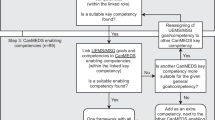Abstract
The European Academy of Paediatrics (EAP) is the paediatric section of the European Union of Medical Specialists (UEMS). The UEMS is responsible for the supervision and approval of training programmes in paediatrics and in its subspecialties. This implies also that EAP has the responsibility to address the training of all professionals working with children, to ensure that their paediatric competences and skills are adequate when dealing with children. The EAP has developed syllabi for paediatricians that provide standards of practice, and criteria for the assessment of competencies in trainees and training centres across Europe. The EAP recommends that all health care professionals working with children should have an officially approved training in child health in addition to formal qualifications in their own field. Moreover, the existing paediatric workforce must maintain their knowledge and skills with relevant continuous professional development and medical education in child health.
Conclusion: There is a need to reassess the training of all health care professionals caring for children, ensuring that it supports new models of integrated and multidisciplinary care and focuses on the needs of the child and the family. A standardised, competency-based minimum paediatric training programme/curriculum should be part in the specialty curriculums.
Similar content being viewed by others
Abbreviations
- CME:
-
Continuous medical education
- CPD:
-
Continuous professional development
- EAP:
-
European Academy of Paediatrics
- UEMS:
-
European Union of Medical Specialists
References
European Academy of Paediatrics (2017) European Academy of Paediatrics. Retrieved October 20, 2017, from http://eapaediatrics.eu/
Stiris T, del Torso S, Mercier J-C, Barak S et al (2015) Improving paediatric care in the community. Lancet 385:1505
Campbell H, Duke T, Weber M, English M, Carai S, Tamburlini G, Pediatric Hospital Improvement Group (2008) Global initiatives for improving hospital care for children: state of the art and future prospects. Pediatrics 121:e984–e992
Council of Europe (2011) Guidelines of the Committee of Ministers of the Council of Europe on child-friendly health care and their explanatory memorandum. https://www.coe.int/t/dg3/health/Guidelines_on_child_friendly_health_care__English_version_.pdf
Council of Europe (2017) Children’s Rights. Retrieved October 20, 2017, from child-friendly healthcare: https://www.coe.int/en/web/children/child-friendly-healthcare
Wolfe I, Thompson M, Gill P, Tamburlini G, Blair M, van den Bruel A, Ehrich J, Pettoello-Mantovani M, Janson S, Karanikolos M, McKee M (2013) Health services for children in Western Europe. Lancet 381:1224–1234
European Academy of Paediatrics (2017) Primary-secondary care. Retrieved October 20, 2017, from http://eapaediatrics.eu/working-group/primary-secondary-care/
European Academy of Paediatrics Curriculum for Common Trunk Training in Paediatrics, agreed by the general assembly in Brussels, 6 December 2014, from http://eapaediatrics.eu/wp-content/uploads/2015/12/Agreed-Common-trunk-curriculum-training-LAST1.pdf
Melville C, Wall D, Anderson J (2002) Paediatric training for family doctors: principals and pitfalls. Med Educ 36:449–455
Ehrich J, Tenore A, del Torso S, Pettoello-Mantovani M, Lenton S, Grossman Z (2015) Diversity of pediatric workforce and education in 2012 in Europe: a need for unifying concepts or accepting enjoyable differences? J Pediatr 167:471–476
Van Esso D, del Torso S, Hadjipanayis A, Biver A, Jaeger-Roman E, Wettergren B, Nicholson A, and the members of the Primary-Secondary Working Group of the European Academy of Paediatrics (2010) Paediatric primary care in Europe: variation between countries. Arch Dis Child 95:791–795
Hippisley-Cox J, Fenty J, Heaps M (2007) Trends in consultation rates in general practice 1995 to 2006: analysis of the QRESEARCH database. http://www.qresearch.org/Public_Documents/Trends%20in%20consultation%20rates%20in%20general%20practice%201995%20to%202006.pd
Hobbs RFD, Bankhead C, Mukhtar T, Stevens S et al (2016) Clinical workload in UK primary care: a retrospective analysis of 100 million consultations in England, 2007-14. Lancet 387:2323–2330
Ehrich J, Namazova-Baranova L, Pettoello-Mantovani M (2016) Introduction to ‘Diversity of child health care in Europe: a study of the European Paediatric Association/Union of National European Paediatric Societies and Associations’. J Pediatr 177S:S1–S10
United Nations Human Rights. (2. September 1990). Convention on the rights of the child. Retrieved 10. December 2017, from http://www.ohchr.org/en/professionalinterest/pages/crc.aspx
Royal College for General Practitioners Curriculum: Professional and Clinical Modules; Paediatric Module 3-04 Children and Young People 19 January 2016, from www.rcgp.org.uk/~/media/Files/GP-training-and-exams/Curriculum-2012/RCGP-Curriculum-3-04-Children-and-Young-People.ashx royal college for general practitioners paediatric module
Marmot M (2010) Fair society, healthy lives: strategic review of health inequalities in England post 2010. www.marmotreview.org/
Frenk J, Chen I, Bhutta ZA et al (2010) Health professionals for a new century: transforming education to strengthen health systems in an interdependent world. Lancet 376:1923–1958
Royal College of General Practitioners and Royal College of Paediatrics and Child Health (2016) Learning together to improve child health: a joint position paper on inter-professional training. http://www.rcpch.ac.uk/sites/default/files/user33576/Learning%20Together%20to%20Improve%20Child%20Health%20document%20-%20Final%20May%202016_1.pdf
Author information
Authors and Affiliations
Contributions
Jernej Završnik: Study conception, design and drafting the article.
Tom Stiris: Reviewed the manuscript and gave important comments.
Lenneke Schrier: Reviewed the manuscript and gave important comments.
Robert Ross Russell: Scrutinised and reviewed the manuscript.
Stefano del Torso: Reviewed the manuscript.
Arunas Valiulis: Reviewed the manuscript.
Jean-Christophe Mercier: Reviewed the manuscript.
Károly Illy: Reviewed the manuscript.
Adamos Hadjipanayis: Commented on the initial draft and contributed to improve the manuscript in terms of content and structure.
Corresponding author
Ethics declarations
Conflict of interest
The authors declare that they have no conflict of interest.
Informed consent
N/A
Additional information
Communicated by Peter de Winter
All authors have read and approved the manuscript.
Rights and permissions
About this article
Cite this article
Završnik, J., Stiris, T., Schrier, L. et al. Basic training requirements for health care professionals who care for children. Eur J Pediatr 177, 1413–1417 (2018). https://doi.org/10.1007/s00431-018-3150-x
Received:
Revised:
Accepted:
Published:
Issue Date:
DOI: https://doi.org/10.1007/s00431-018-3150-x




